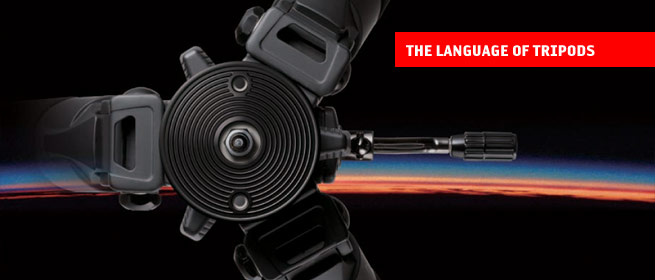Legs
Tripods legs used to be made of solid wood or pressed steel. For over 50 years Velbon has been at the forefront of innovation and design to produce today’s advanced lightweight aluminium or carbon fibre models. The use of magnesium alloy for the shoulders and joint components produces even lighter tripod legs.

 Number of leg sections
Number of leg sections
The more legs sections, the more compact the tripod can be when folded closed. Generally 3-sections is ideal if carrying size is not a concern, while 4 or possibly 5 sections are preferable if the tripod is going to be attached to and carried on a camera bag. The less the number of leg sections, the more stable the tripod, so a practical compromise needs to be reached.

 Leg diameter
Leg diameter
Again a compromise between size and weight. The larger the diameter, the sturdier the tripod, but who wants to carry around three tree trunks? Ideally you will always try to carry the largest diameter legs that you can. Obviously, if you have more sections the outer 'tube' will need to be larger to accommodate the other sections.
Velbon's advanced tubular technology allows for great strength to size ratio and patented designs, such as Trunioned legs on Ultra range, allows for more compact portability.
Leg locks:
Naturally the legs need to extend from their compact carrying position. Once the legs have been extended to the required height they need to be locked into place.
There are 2 types of locks available and these are a matter of preference.
Twist locks:
They are the original type and are still favoured by many. You simply have to twist a ring round the leg tubes to securely lock them. As the years roll by the natural wear is taken up in the twist so you can always be sure of a firm grip. They are, however, slower to operate.
Clip locks:
This type has now become the most popular locking system as they are very quick and easy to operate. Just flick the clip and the leg section is free to be moved to your required height. An Allen key is provided to re-tighten the locks as required over time so that they always lock securely. This high-speed variety is now becoming the most popular choice and most Velbon tripods now use this system.

 Leg Braces
Leg Braces
Some tripods have a collar around the main central column of the tripod which links to a brace on each leg. This is used to further stabilise the legs and is generally used for two purposes.
Video tripods:
When extra stability is required for slow, precise panning shots the braces will reduce the chance of twisting.
Budget tripods:
Because of the cheaper materials and less precision used in manufacture, there is more flexibility in the joints and legs, so leg braces are added to increase stability.
Most Velbon tripods do not require bracing because of their superior precision engineering.
The main advantages of not having leg braces are reduced weight and more variety in the angles that the legs can be placed.

 Centre column
Centre column
Once you have set the height of the legs you can make further adjustments to the overall height with the centre column. The most stable position is when the column is at its lowest point, but there are a number of other benefits to consider:
Fine height control:
When the legs are extended it naturally takes a little while to make any fine adjustments. You may want to adjust the height to show someone the image in frame, or you may want adjust the angle of shooting. This is achieved with centre column adjustment. Some models have a geared handle for very fine, controlled adjustment.
Compactness:
By using the centre column in an extended position you add height, so the tripod leg section can be smaller and lighter. This can compromises stability but when compactness is the priority, it can be a compromise worth making when the tripod would otherwise be left at home!
Velbon have unique patented quick release system on their GEO range. Just squeeze and flick the lever and you can instantly adjust the height.

 Shoulders
Shoulders
Tripod legs are attached to ‘shoulders’. These can either be made of plastic, metal or magnesium alloy. Plastic is light but far less durable and precise than metal. Magnesium alloy offers the best solution. It is both extremely light and precise and this is used on both our GEO and Sherpa+ models.

 Low-angle facility
Low-angle facility
Some tripods feature legs that can be splayed out so that the tripod head can be placed very low to the ground. This is achieved with switches at the top of the legs and is very useful for macro photography e.g. close-ups of flowers, insects, or dramatic ground-level perspective shooting. You might also use this feature with the tripod on a table for indoor/studio macro photography. These tripods often feature a reversible centre column, which enables the camera to be mounted ‘inside’ the three splayed legs, or a splitable central column that can be separated in one or two places.

 Neoprene sleeves
Neoprene sleeves
Neoprene tubing covers the top of the legs of some models. It is used to improve handling and comfortable, especially in cold weather.

 Feet
Feet
Most Velbon tripods feature a built-in choice of either rubber or spiked feet. Just screw the rubber one's up to expose the spikes. Rubber for use on flat hard surfaces, e.g. tarmac or indoor situations; spikes for when you're on soft earth or sand e.g. when shooting outdoors, and especially useful on a slope, This seems simple, convenient and obvious solution but most other tripod brands require a separate purchase of spikes.
 The Head
The Head
There are several different types of tripod heads available, each designed for use in different shooting situations. Many tripods can be fitted with different heads for added flexibility and some higher end models are sold separately so you can tailor your leg and head choice to your specific requirements. But which type will suit you?
There is a degree of personal choice in this and interestingly it can be dictated to a degree by where you live! 3-way pan & tilt head are most popular in the UK and Japan as the best models tend to come from Japanese companies. While ball heads are more popular in Europe and the USA but growing in popularity here in the UK. There is no rule that says you cannot own different heads for different situations.


 3-way Pan & Tilt
3-way Pan & Tilt
This head has 3 planes of movement which are controlled by 2 or 3 handles. One is for tilting (up & down) and one is for panning (left & right). The third plane is for selecting landscape or portrait. This can be operated with an additional lever or a smaller thumb screw. The benefit of this head is that you can control each plane separately, giving you fine control when you, for example, wish to pan along a horizon without affecting the level or angle.

 Ball & Socket
Ball & Socket
The original and simplest head. A ball is held in a vice that can quickly be tightened or loosened for positioning – ideal for so many situations. The ball allows total freedom of movement and can be controlled by either a wheel or lever. The normal handling of your camera becomes your control. It’s simple – just loosen, position and lock – then, ideally, use a remote control or self-timer to capture your latest masterpiece.
Ball and socket heads also have the benefit of compactness.

 Single Handle or Traditional
Single Handle or Traditional
These have a single lever to adjust both panning and tilting with a separate thumb screw for landscape or portrait photography. These are ideal for use with spotting scopes as you can quickly find and follow your subject, but they can also work well for general photography and offer excellent value for money.

 Fluid
Fluid
For use on video tripods, the oil fluid in the head dampens the side-to-side and/or tilting movement for very smooth panning or tilting (moving horizontally or vertically) in your video shooting.

 Quick Release Plates
Quick Release Plates
As the name suggests, a quick-release plate equipped tripod head allows you to take the camera on and off without delay for changing lenses, batteries, or simply for handheld shooting. It can even allow for quick changeovers to another camera if you have a spare quick release plate.

 Spirit or Bubble Levels
Spirit or Bubble Levels
Some tripods include 1, 2, or even 3 spirit levels permanently mounted to the head or shoulder to ensure the tripod is level front-to-back and side-to-side for perfectly horizontal landscape shots, virtual tours or copy work.










